The Violent Life of Eric Naposki

The white envelope arrives bearing familiar markings: INDIGENT MAIL from inmate AM2598 at High Desert State Prison in Susanville, Calif. Inside are two pages of black ink on yellow legal paper torn hastily from a notepad, the printing small and tight and slanted gently to the left. The date at the top reads April 19, 2017.
Michael,
WOW, I just heard Aaron Hernandez committed suicide in his cell. . . . I am really shocked in one aspect and not surprised in another. Prison, or the thought of prison for life, is not a good way to view your future. I’m sure coming from the lifestyle he was used to, prison was not a good place for him.
Eric Naposki composed his letter on the same day Hernandez hung himself at the Souza-Baranowski Correctional Center in Shirley, Mass., where the former Patriots tight end was serving life in prison for murder. These latest pages get heaped onto a pile of nearly 100 more that have stuffed my mailbox four, five and six envelopes at a time to circumvent prison-imposed page limits.
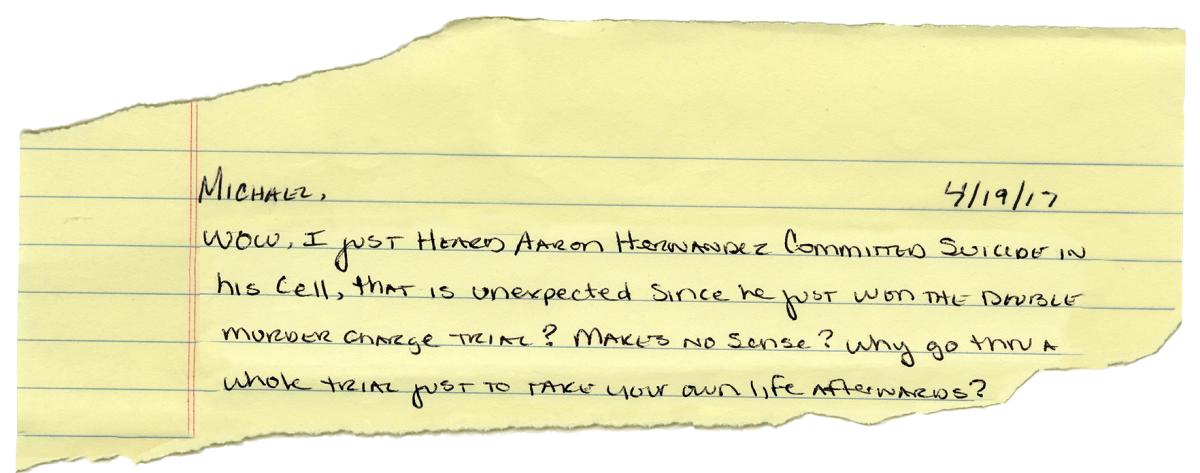
Naposki, now 52, has developed a sort of kindred fascination with Hernandez. Both men had football roots in Connecticut: Naposki played linebacker at UConn and later made his home in the state; Hernandez starred at Bristol Central High. Both men earned their first football paychecks from the Patriots, who signed Naposki as an undrafted rookie in 1988 and drafted Hernandez in the fourth round in 2010. But their deepest connection is defined by a far more chilling exclusivity. Until the moment Hernandez hung himself, both men were members of the same frightening club: former NFL players and convicted killers who despite their pleas of innocence were serving life sentences without the possibility of parole. Four years before Hernandez’s trial dominated headlines, California media had obsessed over another grizzly homicide case. This one involved football and sex, a blonde bombshell and a rich older man, gobs of money and a missing gun. Now, from prison, the convicted murderer at the center of that trial was writing about this sinister connection.
I've never viewed suicide as an answer, actually it is counter productive to proving myself innocent. … Prison on the other hand is just a personal issue, meaning it's you against yourself, if you are mentally strong enough to endure the bad parts, then the good parts will come more easily. I don't think Aaron gave himself enough time to adjust and grow mentally stronger, he gave up, something I will never do.
But then there’s this—something Naposki has considered but that maybe Hernandez did not. If time and mental toughness don’t solve Naposki’s problem, or if he doesn’t manage to overturn his conviction through some new bit of evidence, then he has another Hail Mary survival strategy that he will come to share half a year after Hernandez’s death.
Naposki will never admit guilt, he makes that abundantly clear. But maybe he can connect the violence of his football life to the violent act for which he has been convicted.
Eric Naposki’s appreciation for physical contact attracted him to football at an early age. He describes his first tackle, when he was eight and living in the Bronx, as “the best feeling I had ever felt. That was it, I had found my calling.”
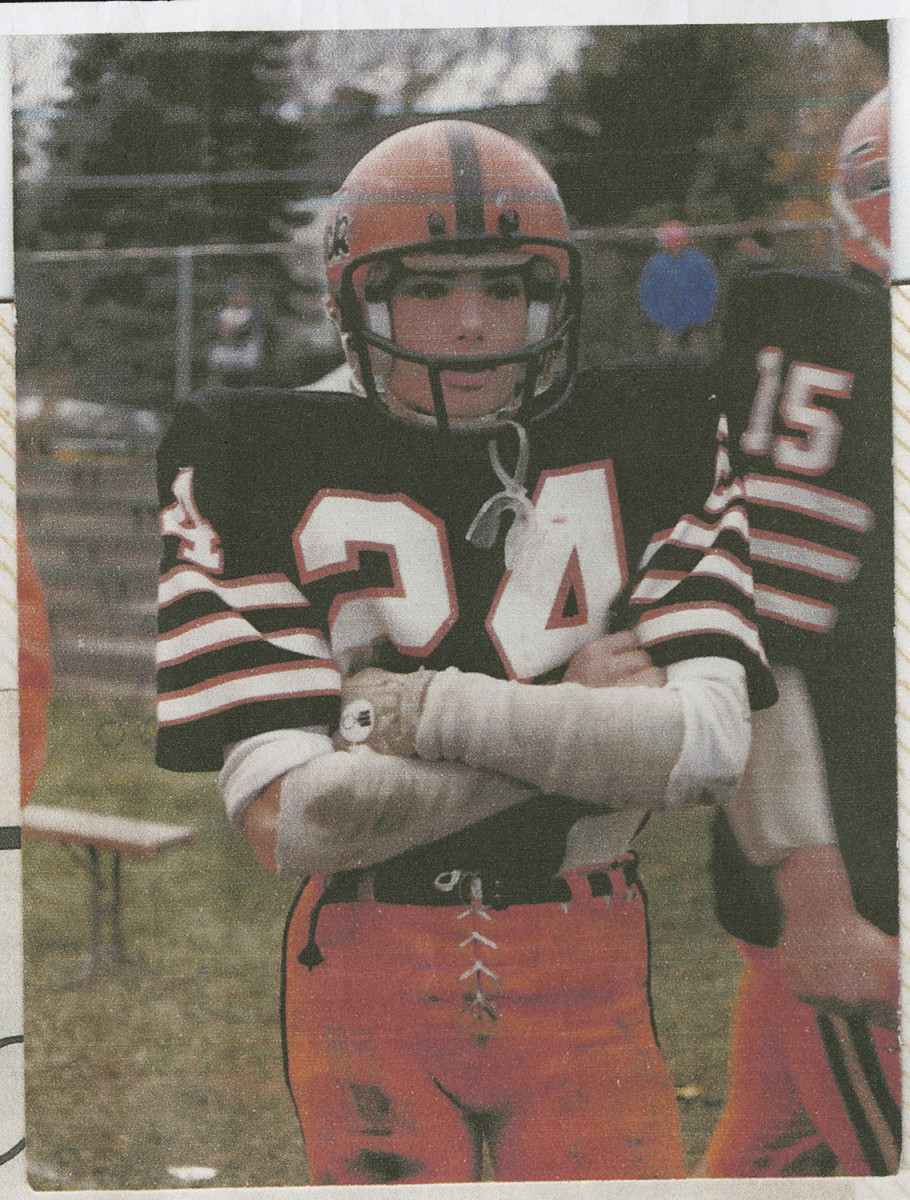
His letters from prison are filled with romanticized tales of aggression and fetishized episodes of violence on the football field, where he says a high school collision broke one opponent’s collarbone and where he recalls a jarring hit that dazed Bengals tailback Ickey Woods. He prides himself on having been “a serious linebacker that [would], if nothing else, hit you in the face and knock your ass out.”
Football was stability. Growing up, many of Naposki’s coaches served as role models in the absence of the father he says he never met. These men remained in his life through college and the pros, and Naposki later found time to address their teams whenever he was home. His athletic achievements gave him the confidence to make friends growing up, and years later many of those same people would hold fundraisers to assist with his court fees during trial.
"The image I have in my head—that maybe I’d like to keep—is of a fun-loving kid who loved playing football," says Jim Capalbo, a coach at Tuckahoe (N.Y.) High, the first of three high schools Naposki attended. Says John D’Arco, an assistant at Eastchester High, “He had everything going for him.”

In 1984, Naposki accepted a football scholarship to UConn, where as a junior he thrived as an outside linebacker, right around the time his high school girlfriend gave birth to their first daughter. But then a shoulder injury cost Naposki a game against Northeastern, and he says coach Tom Jackson held him out the next week. And that was it. “F--- him,” says Naposki. “I quit in person and told Tom Jackson he made a big f------ mistake!” Decades later, this impulsive reaction would come up in court. Naposki, the prosecution mused, had earned three varsity letters . . . And then he just walked away? Who does that if not for an anger issue?
Redirecting the raw athleticism of his 6’ 2,” 225-pound frame, Naposki worked the following summer at a camp run by UConn basketball coach Jim Calhoun and eventually caught on with the Huskies’ practice team. But again his path zagged, this time having something to do with an ankle injury, the call of a budding family and a pointed conversation with Calhoun. “Coach C told me that although I could play basketball—he liked my toughness—I still had a family and school to take care of,” says Naposki. “He told me that maybe I should try my hand back at football. . . . It was the conversation that changed my life.” (Calhoun, now at D-III Saint Joseph, remembers Naposki as a “world-class athlete” who was “caught in between things in his life.”)
In so many ways, Naposki’s return to football was seemingly too good to be true. Fifteen months removed from his final college game, he says he auditioned for agent Dennis Guidone with a 4.5-second 40-yard dash (which would have tied him for third-fastest among linebackers and edge rushers at the 2018 combine) and traveled with a stable of Guidone’s clients for a tryout with the Patriots. Naposki says his name wasn’t on the tryout list, so he snuck into the event by crawling through a crack in a fence and stealing a number from the registration table. Embellished as that tale may seem (Guidone did not respond to calls about this story), Naposki indisputably signed a two-year contract on July 8, 1988, with a salary of $55,000. Three months later he survived New England’s final cuts. One Patriots scout from that era describes him as having been undersized, friendly and “very obsessed with being successful.”
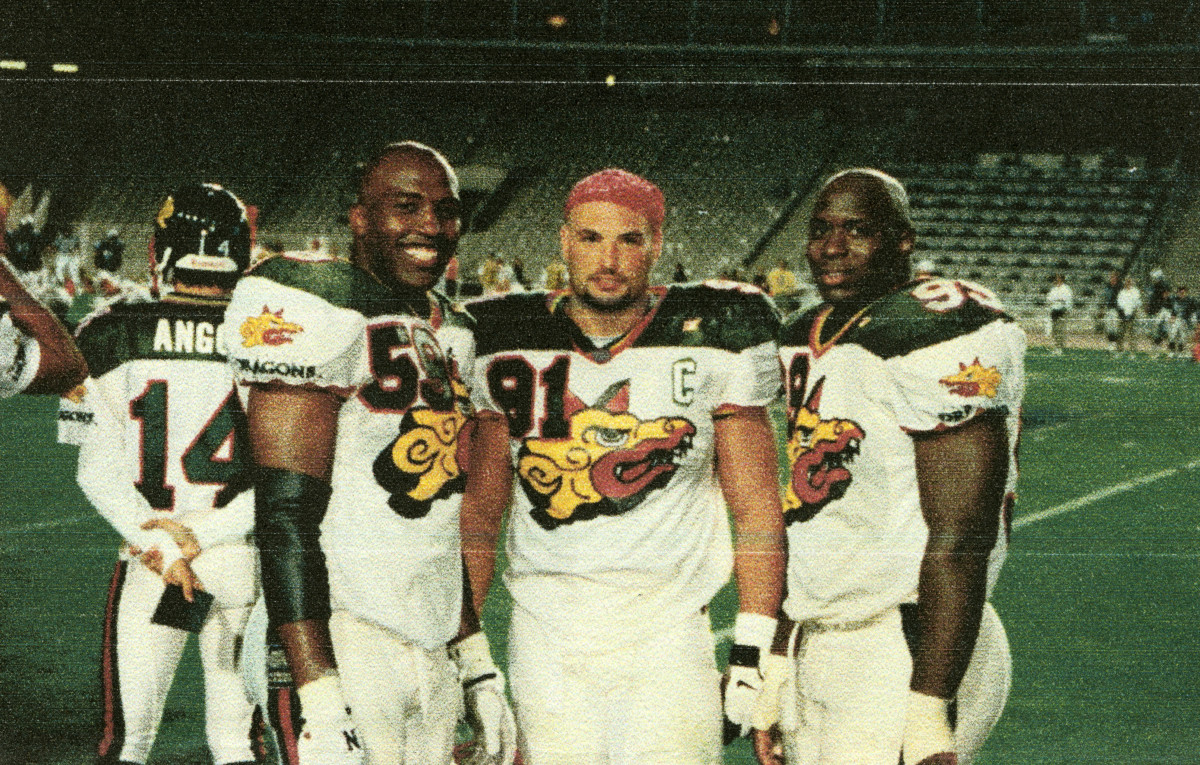
Naposki appeared in three games that season, mostly on special teams, but the dream was short-lived and he quickly ricocheted around the league while suffering a rash of injuries: camp with the Cowboys and Colts; back with the Pats and the Colts, briefly; camp with the Jets. . . . And then off to the World League of American Football.
Even through these hiccups, Naposki’s career had all the unbelievable beats of a Hollywood drama. The Barcelona Dragons flew him off to Spain, where he bagged seven sacks and returned one interception for a game-winning TD while the Dragons marched to the inaugural World Bowl title game in June 1991. The money was meager—somewhere between $15,000 and $40,000 for 10 games—but there were other rewards. Wrote The New York Times: “The Catalans have taken to Naposki, an outside linebacker from Yonkers and the first one to have a fan club, La Penya Naposki.”
When he walked to practice from his beachfront lodging, children swarmed him for autographs. On game days at Estadio Olímpico de Montjuic, banners bearing his name draped the walls. “My fan club grew to 5,000 and my name—Nuh! Pa! Ski!—was chanted,” he gushes. “It was awesome.”
Until it wasn’t. Nagging groin and foot injuries led him to quit following the 1992 season, and by September he was back stateside in Irvine, Calif., where he rented a studio apartment while finalizing a divorce from his first wife, with whom he’d had a second daughter. Naposki found work as a nightclub security guard and started an exercise program for kids.
Which is how he met Nanette Johnston, a 27-year-old soccer mom who would later be described in court as “top-heavy” and eye-catching for her tight, revealing attire and for her tendency to wear a Rolex. Johnston was living that summer in a luxurious Newport Beach home along with her 52-year-old boyfriend, Bill McLaughlin, who’d made millions of dollars off a few medical inventions. Those two had met when McLaughlin answered a personal ad seeking “wealthy men only . . . you take care of me and I’ll take care of you.” But now Johnston turned her eyes elsewhere.
What Naposki says started as a friendship turned physical in the winter of 1993, when he met Johnston in New York City for a night out. Things went well, and Naposki says Johnston invited him to Washington, D.C., for New Year’s Eve. He accepted, and as ’93 gave way to ’94 the two slept together for the first time. “We did not know what to make of this new thing,” says Naposki, who insists today that Johnston led him to believe McLaughlin was just her business partner. “But we enjoyed each other’s company and the sex was intense.”
When they returned to California, Eric and Nanette began dating. McLaughlin would be murdered within a year.
The beginning of the end for Eric Naposki came in the early morning of Dec. 23, 1994—eight days after McLaughlin was found dead in his home—when authorities stopped the linebacker in Newport Beach and arrested him, ostensibly, for an outstanding traffic warrant.
Detectives had been surveilling one of McLaughlin’s properties, a beach house where Johnston was staying, and Naposki was a frequent visitor. Now police wanted to ask him about his whereabouts on the evening McLaughlin was brutally shot six times in the chest while reading a newspaper in his kitchen. (They had already interviewed Johnston and she’d produced a verifiable alibi.)
With detectives Naposki was equal parts cooperative, combative and confident. “I don’t have a problem with you interrogating the s--- out of me,” he told police as he consented to a search of his residence at a nearby hotel, where detectives found no weapons or ammunition. A friend posted the $343 bail from the traffic warrant, and that was that. There would be a second interview a month later, but nothing came of it.
In the absence of charges, Naposki decided to unretire. He missed football and wanted to distance himself from Johnston. “I was done f------ around in California,” he says. By his recollection, the Rams offered him a contract in the spring of 1995, but the NFL shut it down because of the stink of the investigation. He tried returning to the World League instead and recalls a similar result. His attorney at the time, Julian Bailey, even sent a letter to the Orange County D.A.’s office urging them to “clear Mr. Naposki’s name so he can get on with his life.”

And then, without explanation, something changed. In 1996 the Dragons welcomed Naposki back, and with him Barcelona went on to win the ’97 World Bowl—which would prove to be Naposki’s final game as a professional. A photo of the celebration afterward shows Naposki, a team captain, embraced by coach Jack Bicknell, who recalls someone from the NFL calling earlier that year and suggesting “maybe [Naposki] should come home.” Bicknell, who retired from coaching in 2007, says he raised the subject of McLaughlin’s murder with Naposki. “I said, ‘Eric, what’s that all about?’ ” he recalls. “And he said, ‘Coach, it’s something that happened over there, but believe me, I wasn’t part of it.’ And I didn’t pursue it. I just said, O.K.”
Returning to the U.S., Naposki, then 30, parlayed his playing career into a coaching gig at the University of New Haven (Conn.), a D-II program where he spent one season working with the outside linebackers for a team, coached by Tony Sparano, that reached the national title game. Naposki was, by all accounts, up front about his past. One fellow assistant, Tony Mortali, says Naposki even brought it up himself, several times. “He said something happened and they tried to blame him. But we didn’t think anything of it.”
Naposki remarried at a church back in Barcelona and had two more children, a son and a daughter. He worked for a security company that he says stationed him on ESPN’s Bristol campus for several years. He took classes at UConn, continuing his undergrad degree in general studies, and he opened a gym.
“I had a great wife and a great bunch of clients and friends from the gym,” Naposki says. “Life was good.”
Then the real end came. On May 20, 2009, authorities on opposite coasts set into motion a sting operation to apprehend the two people they believed conspired 15 years earlier to kill Bill McLaughlin for financial gain.
They started with Naposki, arresting the suspected triggerman as he backed his Nissan 350Z convertible out of his driveway in Greenwich, Conn., to run errands. (“I thought it was the IRS,” Naposki says of the police who swarmed him. “I thought I got in trouble for tax evasion.”) The sting concluded later that day when authorities nabbed Johnston, the suspected mastermind, at her home in a wealthy Orange County neighborhood.
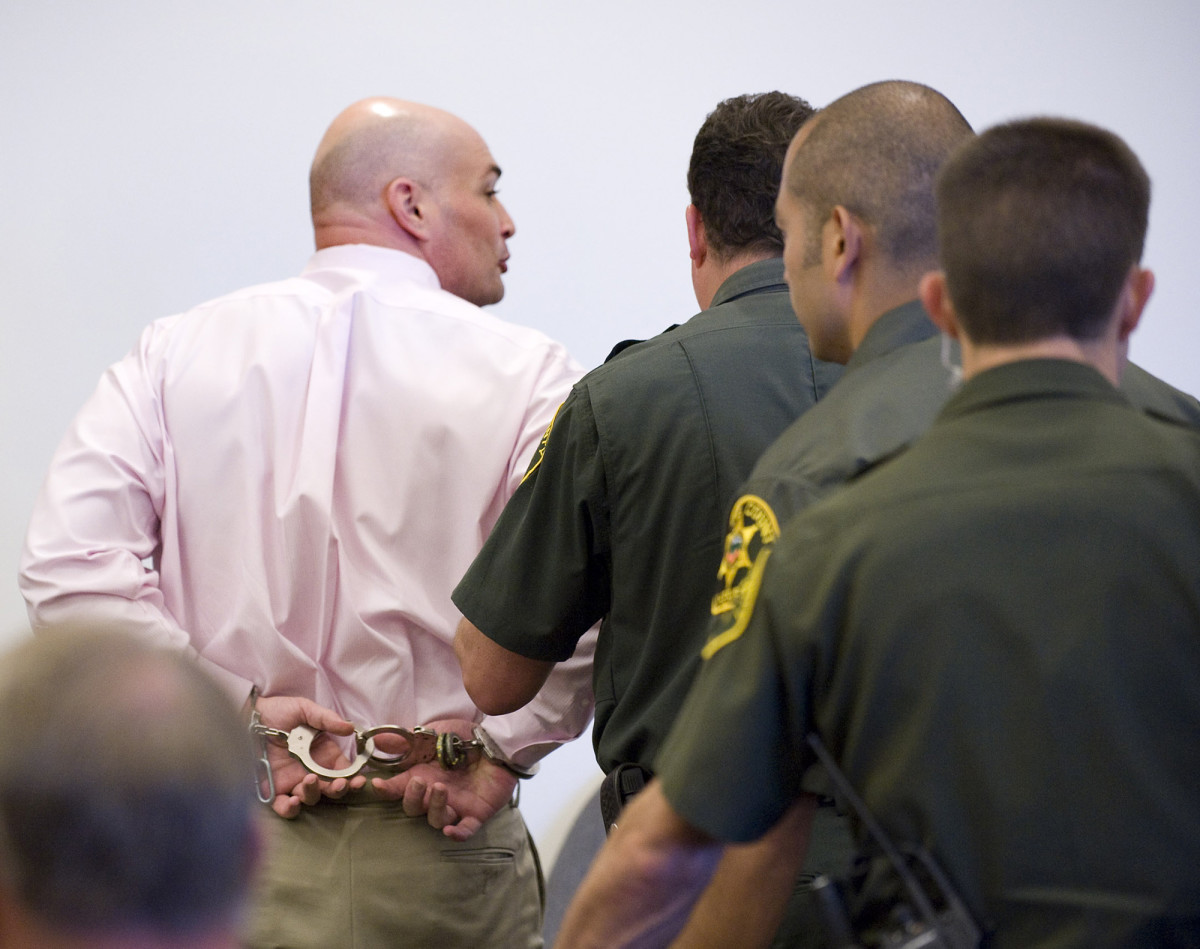
Naposki’s arrest was a watershed moment for deputy district attorney Matt Murphy and his lead investigator, Larry Montgomery, who together had reopened the cold case in 2007, reviewing evidence from the initial investigation, scouring 59 tape-recorded interviews from the 1990s and searching for clues or connections that may have gone unnoticed. All told, their efforts turned up “maybe 60, 70 things,” Montgomery says, that they hadn’t known existed.
The case of Bill McLaughlin’s murder was severed into separate trials, and Naposki’s was first on the docket at the Superior Court of California in Santa Ana, where he pleaded not guilty to charges of murder in the first degree, and for financial gain. He had already spent two years in jail when media from across the country finally stuffed the courtroom for opening arguments in that summer of 2011. The Orange County Register and OC Weekly covered the affair from start to finish. The national outlets checked in frequently. Two intrigued novelists attended every session and later published paperbacks about the trial. Says Jay Bullard, the court reporter for the case: “It lived up to the hype.”
As the trial set out, it became evident that few details would be agreed upon regarding the hours leading up to McLaughlin’s murder. This much, though, was clear: For Naposki and Johnston, their evening had begun at a soccer field in Walnut, Calif., where the couple cheered on Nanette’s young son from a previous marriage. McLaughlin, a licensed pilot, was flying back from Las Vegas that afternoon, and as the game edged into multiple overtimes and then finally finished, Naposki and Johnston were seen hustling to the parking lot. Johnston placed a call from her car phone at 8:24 p.m., and from there the narratives diverge.
In Naposki’s first retelling to detectives, Johnston dropped him off at his apartment to grab a set of black work clothes and retrieve his truck. Then he drove to his job at the Thunderbird nightclub in Newport Beach, stopping briefly at a Denny’s restaurant at 8:52 to return a page from his boss. The ensuing call, which Naposki claimed he made with a prepaid card, and which he said was documented on a bill that had gone missing by the time of the trial, was the centerpiece of his alibi—even as the details of his route from the soccer field to the pay phone changed in subsequent retellings. If he was making a call from Denny’s at 8:52, Naposki reasoned, there wouldn’t have been enough time to drive several miles and murder McLaughlin in Newport Beach by 9:11 p.m., when the body was discovered.
Wherever Naposki went from the soccer game, the finer details of McLaughlin’s death are indisputable. One bullet entered the right side of his chest before slashing his aorta and lung, exiting through his back. Two more sliced his left lung, his diaphragm and his stomach, popping out his left flank. Another three lodged in his body after shredding his large and small intestines, his pancreas, his liver and his inferior vena cava. In falling, McLaughlin slammed his head into the stove, creating a gash and splattering more blood across the tile floor. Which is what McLaughlin’s disabled son, Kevin, saw when he eventually came down from upstairs, where he was listening to music, and called 911.

Aside from all the blood, the gory scene produced little physical evidence, a fact that Naposki references repeatedly in discussing his case today. Despite the seemingly elaborate nature of the crime—through a security gate, through the front door, into the kitchen and back again—no fingerprints, no DNA evidence and no murder weapon were found, even after Navy divers scoured the channel behind McLaughlin’s waterfront home. There were no eyewitnesses, no security cameras, no obvious trails to a killer.
Instead the prosecution built its case on circumstantial evidence, with Murphy unspooling a story rich with sex, greed and vengeance. The D.A. focused on the simultaneous relationships Johnston had with Naposki and McLaughlin, painting her as a manipulative gold digger. Jurors knew Johnston had already pleaded guilty in 1996 to forgery and grand theft after stealing nearly $350,000 from McLaughlin’s bank accounts, including $250,000 the day before he died, and that she’d been positioned to collect on a $1 million insurance policy if McLaughlin passed away. Murphy argued that Naposki had intended to marry Johnston and that he truly believed McLaughlin was just her business partner (despite the very public and consensual nature of McLaughlin and Johnston’s relationship). This all came to a head, Murphy explained, when Johnston told Naposki that McLaughlin had forced himself on her. This, the D.A. argued, was gasoline on the linebacker’s fiery temper. Johnston, he argued, gave Naposki keys to the home she shared with McLaughlin and dropped him off outside around 9 p.m. Naposki snuck inside and committed murder to protect his girl.
Though Naposki never testified, which he now regrets, his own words and actions toward investigators in 1994 and ’95 would be among the strongest evidence Murphy employed in swaying jurors. Naposki had been bold and defiant over the course of his two police interviews within a month of the murder, and he’d changed parts of his story. His most damning misstep, though, came after that first early morning traffic arrest, in ’94. When detectives asked whether he owned any guns, Naposki said he’d recently bought a Jennings .380 and had mailed it to his father. “Then he came forward with information out of the blue,” a detective testified in court. “Kind of: ‘Oh, yeah, I had one other gun.’ ”
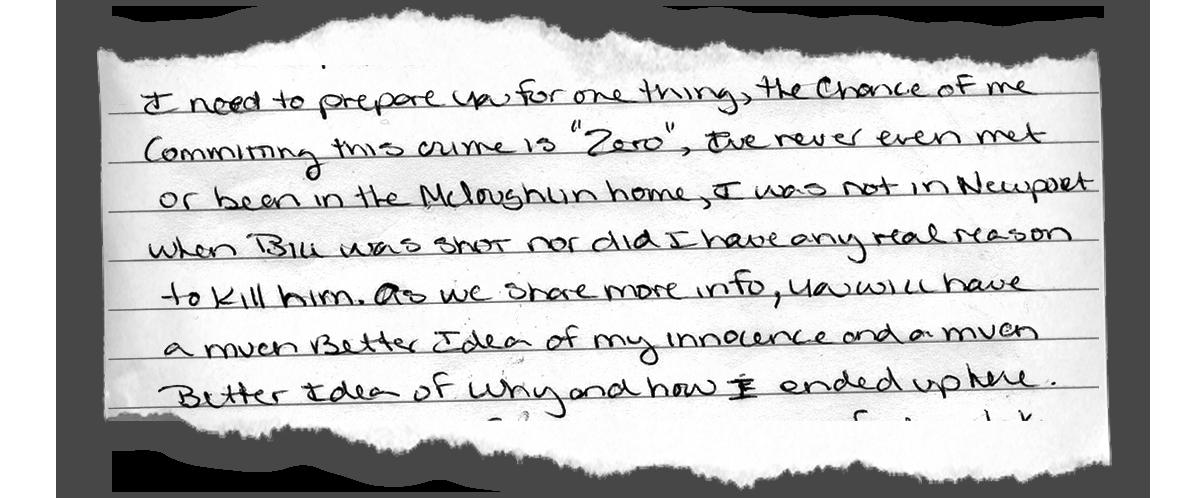
Naposki told detectives he’d recently purchased a Beretta 92F 9-mm—the same make and model later identified by a forensic scientist as the weapon most likely to have killed McLaughlin—but that he’d loaned this second gun to a friend, Joe David Jimenez, who worked on Naposki’s security team. When police visited Jimenez’s home, however, Jimenez produced the aforementioned Jennings .380, registered in Naposki’s name, not the Beretta.
Detectives confronted Naposki in their follow-up interview: “Where is your 9-mm?”
“I have no idea,” he replied.
“You have no idea?”
“That’s my statement. I don’t want to talk about that anymore.”
Later, in Murphy’s closing arguments, the prosecutor would point out: “An innocent Eric Naposki has no reason to lie about anything, especially a gun. . . . The only human beings on planet Earth at the time of that interview that knew a 9-mm was used on this murder were the detectives at the scene and the killer—that’s it. . . . So of all the guns in the world, why is he lying about a 9-mm?”
Just as damning were two incriminating conversations Naposki is alleged to have had with a neighbor, who testified that Naposki first said he “wanted to have Bill McLaughlin’s plane blown up,” and then, after the murder, said, “ ‘Maybe I did [it]. And maybe I didn’t. And maybe I had someone do it.’ ” Naposki also allegedly told this neighbor that the murder weapon was “the same kind of gun that I own,” and that a house key left at the scene had been made at a store down the street from their apartment complex. In court, Murphy pointed out that none of these details had yet been released to the public.
“[Eric] puts himself in a position to be found out because he talks so much,” Montgomery says in explaining how Naposki’s gifts as a persuasive and forceful speaker can work against him. He is a loquacious self-saboteur who wants so badly to be believed—or respected or revered—that one exaggeration becomes two, and two manipulations become four, until his story collapses under the weight of inconsistencies. Whichever sentence he’s speaking is the one he wants you to believe, and soon enough he loses track of the crisscrossing details. “That” says Montgomery, “is kind of his downfall.”
Beyond Naposki’s own incriminating words, Murphy also presented the following in court:
• Numerous driving trials showing that Naposki could have, in fact, reached McLaughlin’s house with enough time to commit the murder, even if he’d stopped at Denny’s.
• The revelation that it would have taken approximately one minute to run from McLaughlin’s house to the entrance of the Thunderbird, where Naposki started working two weeks before the murder.
• Two shopping mall receipts placing Johnston almost seven miles from McLaughlin’s house around the time of the murder, all but eliminating her as the shooter.
• A notebook, found in Naposki’s car, with McLaughlin’s license-plate number scrawled inside, plus testimony from one detective that Naposki didn’t want authorities looking through the notebook.
• The testimony of an ACE Hardware employee who claimed Naposki had asked him to design a silencer for a Beretta.
• Testimony from a realtor who said that in the months before McLaughlin’s death, when Johnston and Naposki had little money to their names, they’d shopped together for extravagant homes costing upwards of $900,000, suggesting they expected to collect on McLaughlin’s life insurance policy.
On July 14, 2011, following a trial that lasted nearly four weeks and that ended 16 years after the murder itself—time enough for Eric Naposki to enjoy a footballing renaissance and win a World Bowl title, remarry and have multiple children—jurors deliberated for seven hours before coming to a verdict: Guilty by a vote of 12-0, with the special condition that he had fired the gun himself.
In the end, Judge William Froeberg imposed a life sentence without the possibility of parole.
At High Desert State Prison, where admittance hinges on a guard inspecting the trunk of your car, guests are herded beyond the front gate into a converted mobile home-welcome center. Here, clothing is checked against color-coded posters while mothers, wives and girlfriends apply makeup and perfume. On the morning I arrive, I get flagged for wearing navy blue shorts. “It happens to everyone their first time,” a receptionist says, pointing toward a room filled with racks of prison-approved apparel.
I eventually clear security wearing borrowed burlap pants that fall short of my ankles, carrying a pen for which I need special permission. Inside, the visiting area is a rectangular space the size of two high school classrooms. Low circular tables dot the floor; a cluster of vending machines sprouts from one wall; a playpen, for inmates with small children, extends from another; a flat-screen plays Finding Nemo.
I’m assigned table No. 24 while guards summon Naposki, and my pulse quickens as he enters the room. He’s 275 pounds, a shade above his playing weight. His biceps and chest reflect daily workouts in the prison yard, testing the limits of a Dodger-blue button-down shirt, with CDCR PRISONER printed in yellow across the back. His skin is bronzed, his scalp freckled by the California sun. The other inmates take notice of the only man here whose physique would go unquestioned in an NFL locker room.
“Michael Cohen!” he says with a smile, extending a hand. He brims with the enthusiasm of someone who rarely receives visitors, and who believes this guest could help his situation. “How are you, buddy?”
Naposki is carrying a tan, clasped envelope filled with annotated documents obtained in the discovery portion of Johnston’s trial, which took place one year after his own and which ended in her, too, being sentenced to life without parole on charges of first-degree murder for financial gain. (Johnston, who also pleaded not guilty, did not respond to repeated attempts to discuss this story.) He wants to outline his latest explanation for McLaughlin’s murder—an explanation that will lean on bank statements, phone records, police reports and excerpts from his own interviews with detectives—and he knows I will listen.

I’m not the first person he’s shared this information with. Hardly. Less than a year after his conviction, in the spring of 2012, Naposki brought a similar story to Murphy and Montgomery, and to CBS’s 48 Hours, where he promised to identify the real killer. The narrative he unfolds is, at the very least, convoluted. Naposki says:
Several months before the murder he vented to an acquaintance, Max (not his real name), about McLaughlin’s supposed sexual assault of Johnston, and Max told him, “I have people that take care of things like this—people who don't like rapists.” Naposki brushed aside those remarks. He was interested in Max's ties to the movie industry and discussed with him the possibility of starting a production company together. He looped Johnston in for the purpose of drafting a business plan, and at this meeting Max again offered to take out McLaughlin. Naposki recalls Johnston expressing interest. Several months passed before Naposki noticed that a Beretta 9-mm had been removed from his truck. Johnston, Naposki says, swiped the gun and gave it to Max for the purpose of killing McLaughlin. (In one version of this story, Max is the hit man; in another, he’s a conduit to a hit man. Naposki has told me both versions of this tale across nearly two years of correspondence.)
When Naposki first shared this narrative with Montgomery, the investigator spent three months hunting for a link between McLaughlin, Johnston and Max. But he found little to support Naposki’s story beyond the fact that the two men knew one another. Instead, Montgomery estimates that more than 80% of what Naposki told him was fabricated. “I went back and confronted him, and he admitted to several lies,” Montgomery will later tell me. “He couldn’t not admit to it because we had the goods.”
During my visit to High Desert, however, Naposki is faced with fresh ears. So he unclasps his envelope and, in between bites from a microwaved chimichanga, attacks the case against him. He blasts the “West Coast attorney” who he says lost his phone records from the Denny’s phone call and criticizes police for, among other perceived blunders, not finding those records. (The importance of those records was disputed by the prosecution at trial.) He questions the relevance of the driving tests cited in court, considering they were conducted more than 15 years after the murder, and dismisses the proximity of his job to McLaughlin’s home as a mere coincidence. (“I didn’t say, ‘Hey, can I have a job here so I can go across the street and whack my girlfriend's sugar daddy.’ ”)
What about the license-plate number in his notebook? Naposki says that came from a P.I. he hired to follow Johnston after he started having questions about her loyalties. And the mansion-shopping, when he and Johnston didn’t have any money? He says Johnston had led him to believe she was wealthy. Naposki highlights calls on Johnston’s phone records and withdrawals on her bank records, which he says were directed to Max in the days surrounding the killing. And he points to a detective’s report in which a neighbor recalled a white-and-black sports car parked outside McLaughlin’s house shortly before the murder—a car Naposki says belonged to Max.
But Naposki is a salesman who doesn’t know when to stop selling. He is prone to bizarre glitches of incriminating bravado. Our meeting at High Desert stretches over two days, ending with a promise to talk again soon, and as I later parse through my notes, searching for new inconsistencies from a man whose story has changed repeatedly, I’m struck by two conversational bookends.
The first came only a few minutes after we first shook hands. “If I’m going to kill someone,” he’d said, “I’m not going to tell you. And I’m not going to have someone do it. I’ll do it myself. I’ll handle it.” This from a man who once said of his own conviction: “This isn’t O.J. Simpson.”
And the second, the last thing I wrote on my prison-provided paper: “I see the vulnerability of women in our society. You don’t touch women in that way.” He paused momentarily, and looking back I wonder if Naposki—a man who has three daughters, and who says his own mother spent time in a women’s shelter—was reflecting on Johnston’s story about being assaulted by McLaughlin.
“Murder,” he finished, “is not beyond me.”
My phone rings on an early November morning in 2017, one day after researchers from the CTE Center at Boston University reveal the findings of Aaron Hernandez’s posthumous brain examination. Naposki is on the line and he wants to discuss what Hernandez’s attorney has described as “the most severe case [of chronic traumatic encephalopathy] they had ever seen for someone of Aaron’s age.” Hernandez was 27.
This news intrigues Naposki, who has broached the subject of head trauma intermittently in his letters and in phone conversations. He catalogues the sheer volume of hits he absorbed throughout his career—“at least 10 to 20 concussions and multiple head shots that caused a temporary loss of awareness”—and he pines for a portion of the NFL’s concussion settlement, which he says he applied for through a Houston-based attorney. (He hasn’t heard from this attorney in quite a while.) Now he has an idea about using one problem to solve another. “If I don’t get out on evidence,” he says, “maybe I’ll use the CTE defense.”
Even putting aside the specifics of Naposki’s case—the fluid details, the ever-changing explanations, the desperation of a convicted murderer clawing for freedom—it’s a sobering thought. And it cuts to the core of an ongoing race to find a method for diagnosing the neurodegenerative disease in living people. Today, an official CTE diagnosis can only be reached posthumously, as with Hernandez. But scientists have spent nearly a decade searching for a biomarker in the human body that can identify CTE with high degrees of sensitivity and specificity, and some experts believe that day is coming. If such a marker were to be discovered, a defendant could attempt to correlate certain symptoms of CTE—namely: rage-related behavior and diminished impulse control—with particular acts of violence. Until then, any attorney who presents CTE as a defense in court is saddling jurors with an impossible task, asking them to weigh the influence of a disease the defendant might not have.
None of this, though, prevents someone from trying. “I realize people will be hired to say various things,” says Dr. Robert Cantu, the CTE Center’s co-founder, even if there isn’t “any science that allows them to be able to say [a living person has CTE] more probably than not.”
One recent example: In 2013, Massachusetts tried a case in which a former high school football player, 20-year-old Nathaniel Fujita, was accused of gruesomely killing his ex-girlfriend and then disposing of her dead body in a marsh. In court the defense introduced a forensic psychiatrist who said CTE made Fujita vulnerable to a break with reality, and Fujita’s attorney said his client had endured a “brief psychotic episode” at the time of the killing, according to The Boston Globe. The jury didn’t buy it; Fujita was sentenced to life in prison. Still, it doesn’t require a huge leap to imagine a future in which such a defense could garner sympathy.

In Naposki’s case, the feasibility of a CTE defense would seem to hinge on his willingness to admit guilt, to confess that he pulled the trigger in what amounted to a fit of rage. He would be presenting “some type of emotional disturbance that would cause his crazy act,” says Angelo MacDonald, one of Naposki’s attorneys. MacDonald likens this idea to a murder defense commonly used in court today: extreme emotional disturbance (EED). Here, jurors must consider “whether or not the offense was committed while the defendant was under the influence of extreme mental or emotional disturbance,” according to the California penal code. “If [scientists] can make that nexus between poor decision making, CTE and illegal aggressive behavior, I think it would be a good defense, actually,” says MacDonald.
But that’s not a path Naposki wishes to explore because, as he says repeatedly, he will never confess to a crime he didn’t commit. He’s sticking to the hit man story. Instead, Naposki is trying to thread an impossibly small needle. He imagines arguing that CTE influenced his mind-set in the days and months surrounding McLaughlin’s murder. Had he been thinking clearly enough, he says, he would have alerted police to Johnston’s hit man plan, which, depending on the telling, he either knew about or suspected all along. CTE, he says now, could have clouded his judgment during stress-filled moments. (MacDonald believes his client is innocent, but he calls this application of CTE “too much of a stretch” to be successful in court.)
“If CTE plays any major role in my history,” Naposki says, “I think it deals mostly with decision-making. Since the early ’90’s, my decision-making has just been poor. Not violent, just impatient—bad choices and no threshold for certain behavior by others.”
At various points in our discussions, Naposki—a man who during a speech at his own sentencing had to stop himself and tell the judge, “I’ll take a second because I’m getting angry”—speaks openly about managing his temper. He tells a story about reading a newspaper in prison and throwing a fit when a guard asked him to put the paper back where he found it. “I didn’t even remember getting mad,” Naposki says. “And that’s probably the scariest part of what [Aaron] Hernandez went through. He probably didn’t even understand what the hell he was thinking.”
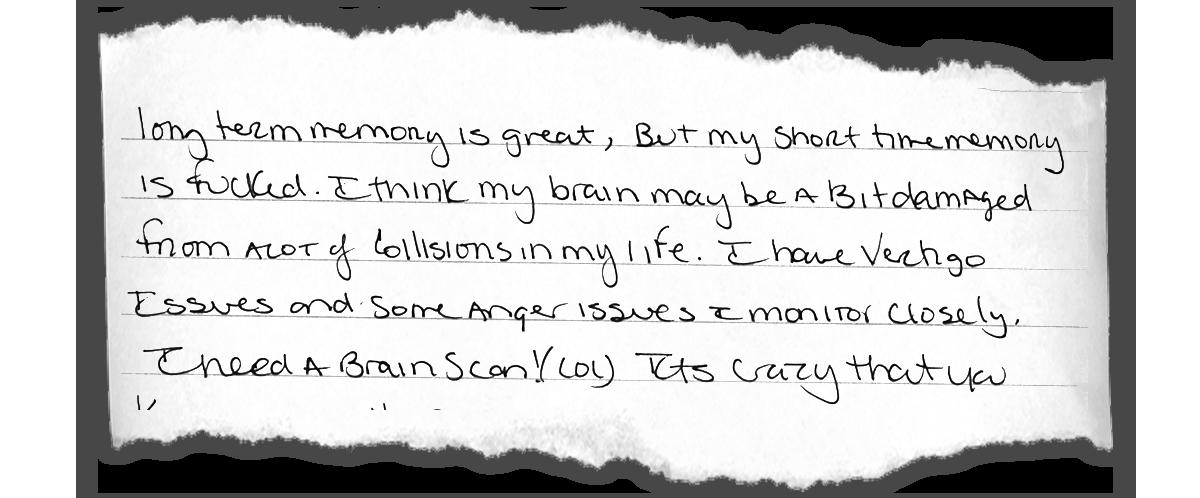
Jimenez, the former colleague who eventually testified against Naposki in court, says he noticed the same explosive behavior two decades ago outside a nightclub where both men worked. “He got in a fight,” Jimenez says, “and the way he was getting ready to fight this guy, it was just like, Man, this guy is going to kick the s--- out of someone.”
Jimenez also witnessed the Eric Naposki who couldn’t help himself, who talked and talked and talked his way into trouble. He remembers being outside the Thunderbird after he started cooperating with police, how Naposki would glare at him “like my number is going to be up,” and how Naposki once said, “I’m going back to New York where you can actually get away with murder.” (Naposki denies making such a comment and calls Jimenez’s story “ridiculous.”)
Anger, rage, McLaughlin’s murder, CTE . . . Naposki mulls over all of this in one of his letters. “If my football career has somehow increased my anger levels,” he writes, “I’m still responsible for the reaction to that rise in anger. With Aaron, he was too young and unfamiliar with himself to notice when the emotion rises how to deal with it. Unlike Aaron, I never lost my cool and killed anybody.”
Eric Naposki has plenty of time to think about all these things. An Orange County innocence review panel recently declined to look into his case, even after he steered them toward a black clothing fiber, found at McLaughlin’s murder scene, that he hoped might incriminate someone else. Since my visit, he’s been transferred a few hours northwest of Los Angeles to Avenal State Prison, a lower-security facility with increased outdoor time and better living conditions. Naposki angled for this move to be closer to his son, a sophomore on UCLA’s rugby team who last season was named first-team All-America. Naposki’s visitation privileges were recently enhanced on account of good behavior, and there are loose plans for an overnight visit with his kids in one of Avenal’s apartment-style buildings.
“I can’t wait for that,” he says.
In the meantime, Naposki keeps busy with daily calls to the woman he refers to as his fiancée—a complete stranger until she heard about his case on TV and wrote him out of the blue—and with his letters. He says he’s written to Nanette, urging her to come forward with the truth. He organizes workout programs for fellow prisoners and says he’s starting a finance business with another inmate. Most importantly, though, he continues searching for a way out, for a means of clearing his name after all these years, even after so many attempts have already failed.
“I’m never gonna stop,” Naposki says, “because I have nothing else to do.”
Find more Sports Illustrated True Crime stories here

